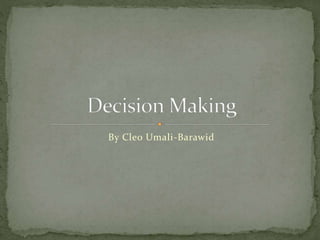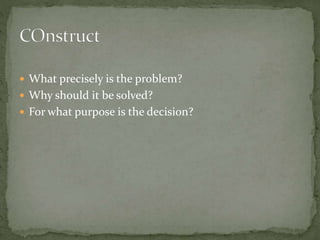Decision making
- 2. ? Choosing from among alternatives for attaining a goal. ? The act of reaching a conclusion.
- 7. ?Decide what you want ?(good, timely, well- considered decisions)
- 11. ?O- Objectives to attain ?A- Alternatives available ?R- Risks possible
- 12. ? Construct- Identify problem/opportunity ? Collect- gather data ? Compile- organize data ? Compare- evaluate options ? Commit- select preferred option ? Consolidate- act on the decision
- 13. ? What precisely is the problem? ? Why should it be solved? ? For what purpose is the decision?
- 14. ?What factors are involved? ?Ask questions ?Brainstorm ?Gather data
- 15. I keep six honest serving men They taught me all I knew Their names are What and Why and When And How and Where and Who. -Rudyard Kipling
- 16. ?Organize the data ?List all possible choices ?List requirements to be met ?Fix criteria to judge alternatives.
- 17. Consider from different perspective. Determine pros and cons of each. Evaluate each choice. Consider what might go wrong.
- 18. Determine the best decision Transform that decision to action Execute your decision and make it work.
- 19. Check if your decision is working Modify, if necessary. Strengthen your efforts. Figure out lessons for reuse.
- 20. Ą°Sir, what is the secret of your success?Ąą Ą°Good decisions.Ąą Ą°And how do you make good decisions?Ąą Ą°Experience.Ąą Ą°And how do you gain experience?Ąą Ą°Bad decisions.Ąą
- 21. ? Goals ? Priorities ? Attitude ? Perception ? Style ? Demands ? Risks ? Resources ? Judgment ? Values
- 22. ?Avoid snap decisions. ?Write down the pros and cons. ?Move fast on the reversible ones. ?Move slowly on the irreversible. .
- 23. ? You are your top priority. ? How will it affect you? ? Will you be a better person? ? Can you be yourself and live your own life? ? Ą°Mine own applause is the only applause that matters.Ąą--Cicero
- 24. Be responsible for your decisions. Be prepared for the consequences. DonĄŊt be a victim of otherĄŊs decisions.
- 25. Changing decisions can change your life. Revise at the right time. Successful people: quick, correct, and slow changes. Others: slow, wrong decisions, and frequent changes.
- 26. Ą°Decisiveness is a characteristic of high performing men and women. Almost any decision is better than no decision at allĄąĄŠBrian Tracy
- 27. ? DonĄŊt be excessively cautious. ? DonĄŊt wait for the Ą°bestĄą. ? DonĄŊt try to be 100% safe. ? Failure is possible. ? Too much thought and little action is bad.
- 28. Do not overestimate your decision making skills. Do not be overconfident in your ability to predict. Do not be blind to other possibilities.































